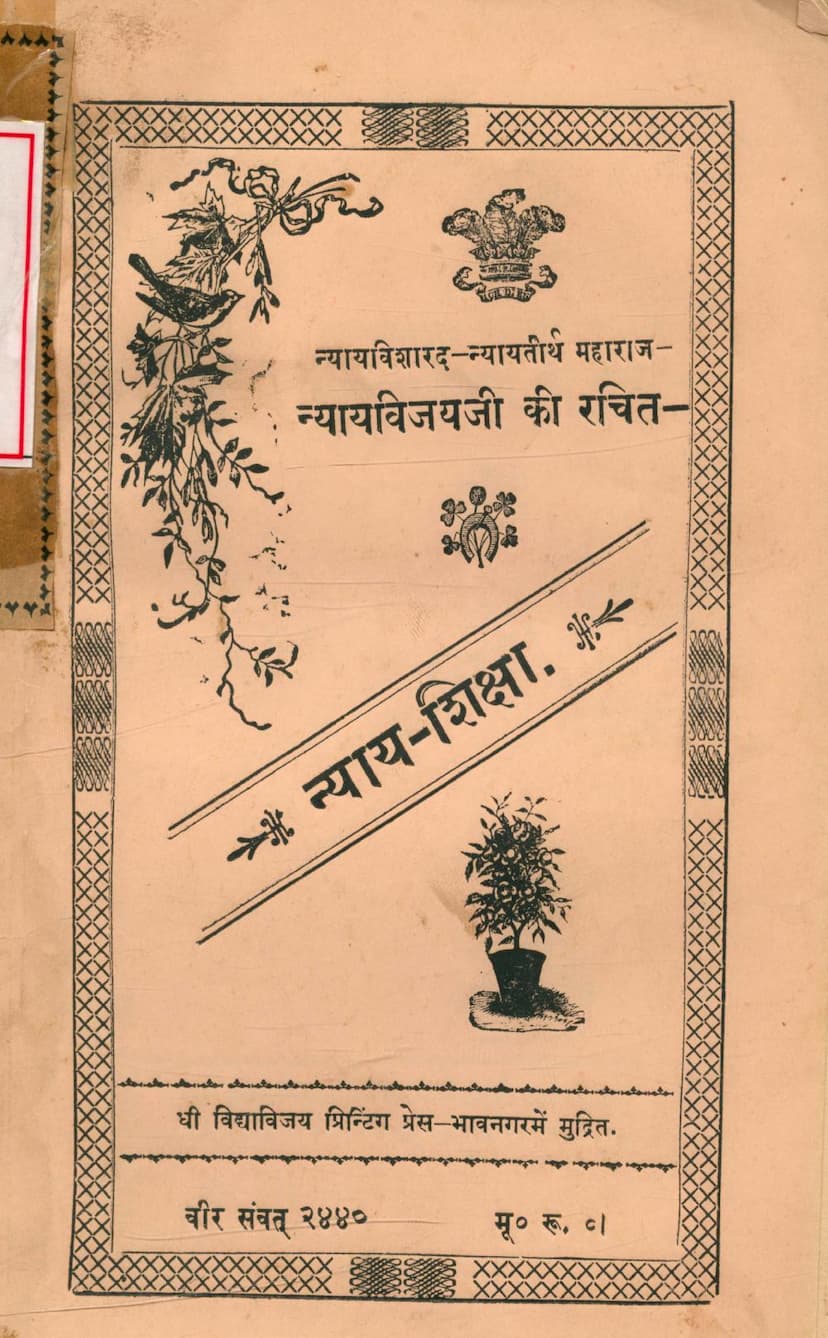Nyayashiksha
Added to library: September 2, 2025

Summary
Here's a comprehensive summary of the Jain text "Nyaya-Shiksha" by Nyayavijay, based on the provided pages:
Title: Nyaya-Shiksha (Justice Education) Author: Nyayavijay (also referred to as Nyayavisharada-Nyayatirtha Maharaj Nyayavijayaji) Publisher: Vidya Vijaya Printing Press, Bhavnagar Era: Vira Era 2440 (approximately 1913-1914 CE) Price: 4 Annas
Core Purpose and Philosophy:
The book "Nyaya-Shiksha" is a foundational text aiming to impart education in the principles of Jain logic and epistemology (Nyaya). The author, Nyayavijay, emphasizes that understanding these principles is crucial for comprehending the true essence of Dharma and achieving liberation (Moksha). The book is written in Hindi to make this complex knowledge accessible to a wider audience, including those who may not have studied Sanskrit.
Key Themes and Content:
The text is structured to guide the reader through fundamental concepts of Jain philosophy, with a particular focus on the nature of knowledge and its validation. The main themes covered include:
-
The Importance of Peropkar (Altruism/Welfare of Others): The author begins by stressing the importance of peropkar, defining it not just as helping others but as a path to self-improvement. True peropkar is seen as helping others achieve spiritual liberation, which ultimately benefits oneself.
-
The Role of Writing and Oratory in Spreading Dharma: The text highlights the power of both speech and writing in propagating religious teachings. While eloquent speech can have a immediate impact, writing is deemed more enduring and capable of benefiting a larger number of beings over time.
-
The Nature of Knowledge (Pramana): The core of the book delves into Pramana, the valid means of acquiring knowledge.
- Definition of Pramana: Knowledge that correctly understands reality is called Pramana. It is established that only consciousness (knowledge itself) can be a source of valid knowledge, as inert matter is inherently ignorant.
- Two Main Types of Pramana:
- Pratyaksha (Perception): This is direct and immediate knowledge. The text distinguishes between:
- Samvyavaharika Pratyaksha (Empirical Perception): This is the perception gained through the senses (sight, hearing, smell, taste, touch) and the mind. It is further broken down into stages: Avagraha (initial apprehension), Iha (investigation), Avaya (conclusion), and Dharana (retention).
- Paramarthika Pratyaksha (Ultimate Perception): This refers to higher forms of direct knowledge attained by the soul, such as Avadhijnana (clairvoyance), Manahparyaya-jnana (telepathy), and Kevala-jnana (omniscience).
- Paroksha (Inference/Indirect Knowledge): This is knowledge gained indirectly, not through direct perception. It is divided into five categories:
- Smarana (Memory): Recollection of past experiences.
- Pratyabhijna (Recognition): The identification of something as being the same as previously experienced, often combining perception and memory.
- Tarka (Reasoning/Hypothetical Reasoning): The determination of inseparable connection (vyapti) between a cause and effect or similar relationships, crucial for establishing logical connections.
- Anumana (Inference): Deriving knowledge of an unknown subject (sadhyam) from a known sign (sadhana). The text discusses the concept of the invariable concomitance (avina-bhav) as the sole valid characteristic of a hetu (reasoning factor). It also critiques the multi-characteristic approaches of other schools of thought. The book details the structure of syllogism (Panchavayava Vakya) and discusses fallacies (Hetvabhasas).
- Agama (Testimony/Scriptural Authority): Knowledge derived from the words of an Apta (an infallible and truthful person). The text asserts that words are material in nature and that the validity of testimony depends on the speaker's inherent purity and knowledge.
- Pratyaksha (Perception): This is direct and immediate knowledge. The text distinguishes between:
-
Saptabhangi (The Doctrine of Conditional Predication): This central Jain doctrine is explained as a method of expressing complex truths by using "syat" (perhaps/maybe) to qualify assertions, allowing for multiple, seemingly contradictory, perspectives on a single entity. It is illustrated with seven forms of predication and discussed in relation to both Pramana and Naya.
-
Naya (Standpoints/Partial Truths): Naya refers to the specific points of view or standpoints from which reality is apprehended. While Pramana grasps the totality of an object's characteristics, Naya focuses on a particular aspect, remaining indifferent to others.
- Two Main Types of Naya:
- Dravyarthika Naya: Focuses on the substance or essence of things. It includes Nagama (commencement), Sangraha (collection/generalization), and Vyavahara (convention/particularization).
- Paryayarthika Naya: Focuses on the modes or modifications of things. It includes Rujusutra (present moment), Shabd (word meaning), Samabhirudha (word nuance), and Evambhuta (appropriately qualified).
- The Harmony of Nayas: The text emphasizes that all these Nayas, despite their apparent differences, are complementary and contribute to a fuller understanding of reality when considered within the framework of Jain scriptures. Other philosophical systems are presented as adhering to specific Nayas, while Jainism embraces all of them.
- Two Main Types of Naya:
-
Pramata (The Knower/Subject): The text briefly describes the soul (Jiva) as the knower, emphasizing its conscious nature, its experience of consequences, its being of the same size as the body, its individuality, and its possessing of material constituents.
-
Vada (Debate/Discussion): The book outlines the principles of debate, including the different types of debaters (those seeking victory, those seeking truth for themselves, and those seeking to impart truth to others), the structure of debate, and the roles of participants like the audience (sabhyas) and the chairman (sabhapati). It highlights the importance of truthfulness and ethical conduct in argumentation.
Author's Intent and Contribution:
Nyayavijay's intention with "Nyaya-Shiksha" is to demystify the complex principles of Jain logic and epistemology, making them accessible and understandable to a wider audience. The book serves as a foundational text for anyone seeking to understand the philosophical underpinnings of Jainism. It aims to equip readers with the intellectual tools necessary to discern truth from falsehood and to progress on the path to spiritual liberation. The author's previous works in Sanskrit on these topics are mentioned, indicating this Hindi text is a simplified and popularized exposition.
In essence, "Nyaya-Shiksha" is a didactic work that serves as an essential introduction to the rigorous logical and epistemological framework of Jainism, presented with clarity and accessibility by the learned author, Nyayavijay.